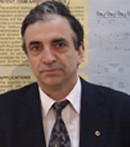

Plenary Lecture
Extenics Theory Applied to Robotics

Professor Luige Vladareanu
Head of Robotics and Mechatronics Department
Romanian Academy, Institute of Solid Mechanics
Bucharest, Romania
E-mail: luigiv@arexim.ro
Abstract: Extenics is a novel theoretical frame of matter element in the world leading science, which establishes the methodology of solving contradictory problems through the intelligent and innovative process in a formal, mathematical and logical way. Starting from the theoretical frame and having pillars the basic-element theory, extension set theory and extension logic, the special extension methodology are presented. The extensibility of matter-element including the divergent, conjugate, correlative, implicative and expansive nature are analyzed in robotics fields. The quantitative tools to solve the robotics contradictory problems based on extension set of extension mathematics are examined. Extension decision methods on robot control field are done by applying a series of comprehensive strategies using extension set and dependent function in order to transformations of goal matter-elements or condition matter-elements in consistency elements and rules of cognitive reasoning. The robotics intelligent control by extension theory and the basic concepts, structure and principles of extension control developed as the knowledge base, the characteristics pattern recognition, fusion of dependent degree on characteristic states, the measure pattern recognition, the adaptive mechanism, the control strategies as the main elements of the control system architecture. Finally, an advanced method is developed for solving contradictory problems in the motion control of autonomous robots by applying extension theory on a multi-dimensional space using non-linear attraction point principle and the network of attraction curves. The obtained results lead to development of a methodology that allows obtaining high level results for robot motion control using extended transformations onto the extension set and an optimization function generated by the extended dependence function in multidimensional space in comparison to the classical method using sequential logic matrices.
Brief Biography of the Speaker: Luige Vladareanu received Ph.D. degree in electronics field from the Institute of Solid Mechanics of Romanian Academy, in 1998. From 2003, Ministry of Education and Research, executive Department for Financing Superior Education and of Scientific University Research - High Level Expert Consulting for MEC/CNCSIS project, from 2003-2005, member of Engineering Science Committee of Romanian National Research Council, from 2005, Scientific Researcher Gr.I (Professor) of Romanian Academy, from 2009 Head of Robotics and Mechatronics Department of Institute of Solid Mechanics, Romanian Academy. His scientific work is focused on real time control in solid mechanics applied in robot trajectory control, hybrid position – force control, multi-microprocessor systems for robot control, acquisition and processing of experimental physical data, experimental methods and signal processing, nano-micro manipulators, semi-active control of mechanical system vibrations, semi-active control of magnetorheological dissipaters systems, complex industrial automations with programmable logical controllers in distributed and decentralized structure. He has published over 35 books and book chapters, 19 edited books, over 200 papers in journals, proceedings and conferences in the areas. Director and coordinator of over 15 grants of international and national research – development programs in the last 5 years, 15 invention patents, developing 17 advanced work methods resulting from applicative research activities and more then 60 research projects. He is the winner of the two Prize and Gold of Excellence in Research 2000, SIR 2000, of the Romanian Government and the Agency for Science, Technology and Innovation. 9 International Invention and Innovation Competition Awards and Gold of World’s Exhibition of Inventions, Geneva 2007 - 2009, and other 9 International Invention Awards and Gold of the Brussels, Zagreb, Bucharest International Exhibition. He received “Traian Vuia” (2006) award of the Romanian Academy, Romania’s highest scientific research forum, for a group of scientific papers published in the real time control in the solid mechanics. He is a member of the International Institute of Acoustics and Vibration (IIAV), Auburn University, USA (2006), ABI´s Research Board of Advisors, American Biographical Institute (2006), World Scientific and Engineering Academy Society, WSEAS (2005), International Association for Modelling and Simulation Techniques in Enterprises - AMSE, France (2004), National Research Council from Romania(2003-2005), etc. He is a PhD advisor in the field of mechanical engineering at the Romanian Academy. He was an organizer of several international conferences such as the General Chair of four WSEAS International Conferences (http://www.wseas.org/conferences/2008/romania/amta/index.html), chaired Plenary Lectures to Houston 2009, Harvard, Boston 2010 and Penang, Malaysia 2010, Paris 2011 to the WSEAS International Conferences, is team leader of WSEAS scientific research project: Mechanics & Robotics Systems and is serving on various other conferences and academic societies.